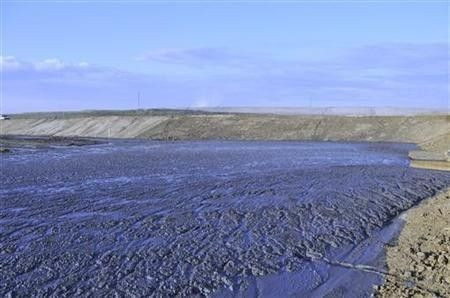Oil sands opponents turn focus to Enbridge project

Enbridge Inc's proposed C$5.5 billion ($5.3 billion) pipeline to British Columbia poses a raft of environmental risks, according to a new report that signals the project will become the next battleground over the future of Canada's oil sands.
The study by a trio of environmental groups, released on Tuesday, comes on the heels of a U.S. decision to push back approval of TransCanada Corp's Alberta-to-Texas Keystone XL pipeline by more than a year.
The delay has led the Canada's oil industry and Prime Minister Stephen Harper's government to intensify their emphasis on exporting oil sands-derived crude to Asia.
The Enbridge project, known as the Northern Gateway pipeline, is the first attempt at doing that in scale.
But the new report - issued by the Natural Resources Defense Council, Pembina Institute and Living Oceans Society - says the project would threaten native communities, the salmon fishery and wildlife habitat on the West Coast.
The report uses last year's Enbridge pipeline rupture and oil spill in Michigan, and even the Fukushima nuclear disaster in Japan, as examples of why governments and regulators should block the proposal to bisect the rugged Western Canadian province with steel pipe.
Northern Gateway would move 525,000 barrels of crude a day to the port of Kitimat, British Columbia, where it would be loaded onto tankers and shipped to Pacific Rim refiners. The project is a key part of the Conservative government's plans for a National Energy Strategy.
Regulatory hearings are scheduled to begin in January and will take months. About 4,000 people have registered to comment on the project.
The Joint Review Panel assessing the proposed project and the cabinet ministers with final decision-making authority over its fate should reject the proposed Northern Gateway pipeline, given the grave safety risks it would impose on a culturally, economically and ecologically valuable region, said the report.
NUMEROUS THREATS AT ONCE
The study also aims to build general opposition to Alberta oil sands development, which green groups say is 23 percent more carbon-intensive than conventional oil production. By contrast, a much-referenced report last year by IHS CERA, the energy consultancy, said it was 6 percent more carbon intensive when judged from production to end use.
Environmentalists used similar greenhouse-gas intensity and other arguments in their battle against Keystone XL. They include an unproven assertion that oil sands-derived crude is more corrosive in pipelines, increasing the risk of ruptures.
An Alberta study released last week disputed that argument, but pointed out there is still no formal, peer-reviewed research on the issue.
The report said Enbridge has failed to gauge the impact on the Northern Gateway pipeline if numerous threats emerged at once, as with the March earthquake and tsunami in Japan, which contributed to the Fukushima nuclear plant catastrophe.
A fall frontal rain storm that triggered a rock avalanche could rupture the pipeline. Poor weather conditions combined with associated floods and erosion could prevent ground or air access for emergency response crews, it said.
Avalanches, rockslides, explosions, or leaks from the (proposed adjacent) natural gas pipeline all can have cumulative impacts that worsen the ability to respond.
Enbridge dismissed the report, calling it a compilation of criticisms that have already been leveled at the line. As well, company spokesman Paul Stanway said most of the charges laid by the green groups had been dealt with in Enbridge's regulatory application.
There are a number of inaccuracies in the report, he said. And most of the questions (raised) have been answered in the application.
© Copyright Thomson Reuters 2024. All rights reserved.





















